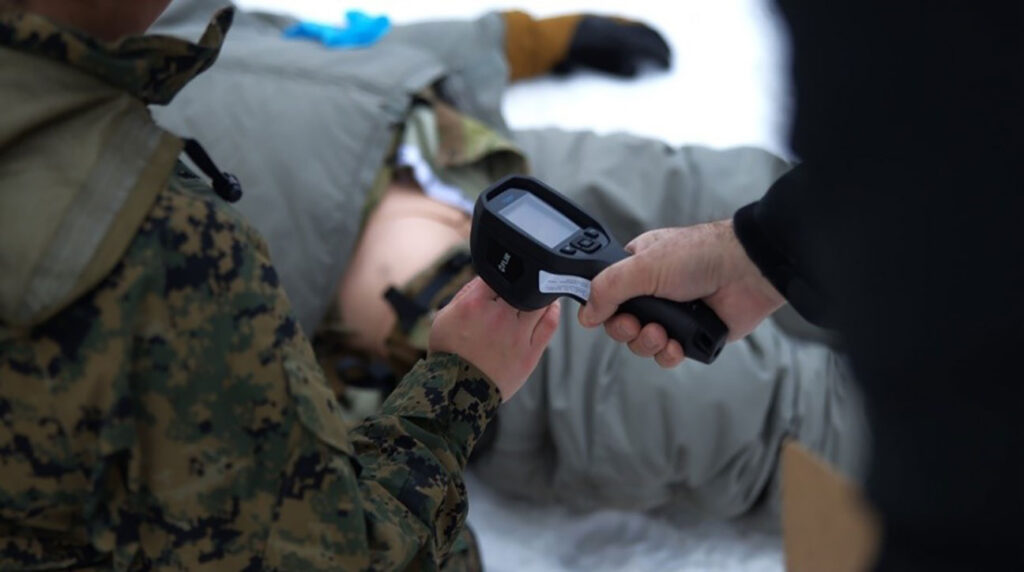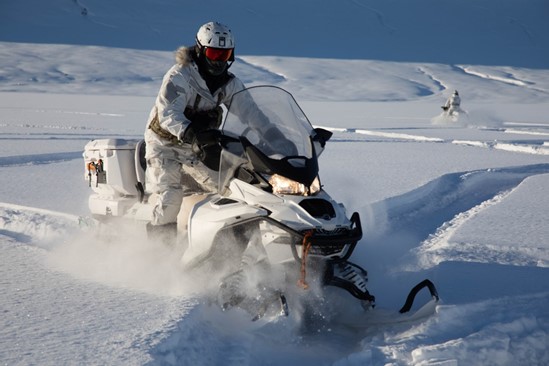U.S. Navy Lt. Maria Jarrett has the temperature of her hands assessed using a frost-bite sensor after below zero medical procedures on mannequins. LANCE CPL. MADISYN PASCHAL/U.S. MARINE CORPS
SETH CAIN
Arctic Edge 2024, a biennial exercise led by United States Northern Command (USNORTHCOM), is a joint and combined multi-domain Field Training Exercise (FTX) designed to prepare U.S. forces for Arctic warfare. The exercise provided a foundation for innovative medical solutions tailored to the Arctic’s unique challenges.
One of the most critical components of Arctic Edge 2024 was Below Zero Medicine, a specialized initiative focusing on medical readiness in extreme cold. According to Alaska’s News Source, the program tested new medical treatments and technologies under real Arctic conditions, ensuring their effectiveness in battlefield scenarios.
On February 13, 2025, Gen. Gregory M. Guillot, commander of USNORTHCOM and North American Aerospace Defense (NORAD), told the Senate Armed Services Committee that Arctic Edge is a “key example of a USNORTHCOM event that evaluates combatant command planning, communications, and operational oversight while simultaneously providing warfighters and enablers with valuable operational experience as they test the people, equipment and logistics needed to execute their missions in remote and austere locations.”
Advancements enhancing mission agility
Operating in subzero temperatures presents significant challenges to casualty care, evacuation procedures and medical coordination. According to the U.S. Army Medical Materiel Development Activity, Arctic Edge 2024 evaluated several breakthrough medical technologies designed to overcome these obstacles:
- Portable oxygen generation: The O2 Portable Generator ensures a reliable oxygen supply for trauma patients, a critical capability in remote Arctic regions where traditional resupply can be delayed due to harsh weather conditions and vast distances. Ensuring sustained oxygen delivery in the extreme cold improves survivability rates for severely injured personnel.
- Freeze-dried plasma (FDP): The introduction of freeze-dried plasma revolutionized battlefield medicine by offering a stable, easily transportable alternative to traditional blood plasma. Unlike conventional plasma, which requires refrigeration, FDP remains viable in subzero conditions, allowing for rapid transfusions in austere environments without the logistical burden of cold storage.
- Advanced hypothermia prevention: Maintaining core body temperature in extreme cold is essential for survival. Arctic Edge 2024 showcased the Heatpac Personal Heater, a lightweight, portable system that delivers up to 17 hours of forced-air heating. In addition, fabric-embedded frostbite sensors allow real-time monitoring of extremities, enabling early intervention before frostbite causes permanent damage. These technologies directly enhance warfighter endurance and prevent cold-related casualties.
Green Berets from the U.S. Special Operations Mountain Warfare Center operate snow machines during Arctic Edge 24 in Mestersvig, Greenland, to sharpen readiness in rapid resupply, personnel recovery and medical care. PVT. ANDREW ESTRADA/U.S. ARMY
Force sustainability through medical preparedness
Beyond immediate trauma care, sustaining force health in the Arctic requires advanced casualty evacuation and treatment solutions. Arctic Edge 2024’s Below Zero Medicine initiative tested specialized mobile sleds for efficient patient transport across ice and snow. These sleds, which can be pulled or towed by snow machines, drastically reduced evacuation times from the point of injury to field medical stations.
Additionally, medical teams assessed the effectiveness of temperature-controlled Casualty Collection Point tents, and insulated environments where Tactical Combat Casualty Care principles can be applied in blizzard conditions. These shelters provided critical stabilization for injured personnel before transport to higher-level medical facilities, reinforcing the ability to sustain prolonged operations in extreme conditions.
Strategic imperative for Arctic medical readiness
Predicting and mitigating medical challenges before they arise is critical to mission success. Predictive analytics, leveraging historical data from cold weather conflicts, can inform commanders about expected medical needs, casualty rates and resource allocation strategies, optimizing Arctic operational planning.
International cooperation remains vital. Canada and Norway, with decades of Arctic medical expertise, provide invaluable lessons for U.S. forces. Collaboration with Arctic NATO allies, particularly through exercises like Cold Response and Trident Juncture, ensures compatibility and shared best practices in medical readiness.
Arctic Campaigning
USNORTHCOM’s ability to conduct Arctic campaigning is a necessity. Ensuring force survivability requires continued investment in emerging medical technologies, expanded field testing in real-world Arctic conditions and enhanced coordination between military and civilian medical organizations.
As demonstrated at Arctic Edge 2024, these innovations are not merely theoretical. They also are operationally viable and critical for mission success. Strengthening Arctic medical readiness is essential for sustaining the force and securing America’s northernmost line of defense. Looking ahead to Arctic Edge 2026, the lessons learned in 2024 will play a pivotal role in shaping future planning and operational strategies, ensuring the U.S. remains prepared to address the unique challenges of the Arctic environment and maintain a strong, ready presence in the region.
Seth Cain is a graduate student at the Josef Korbel School of International Studies at the University of Denver who interned at United States Northern Command.


